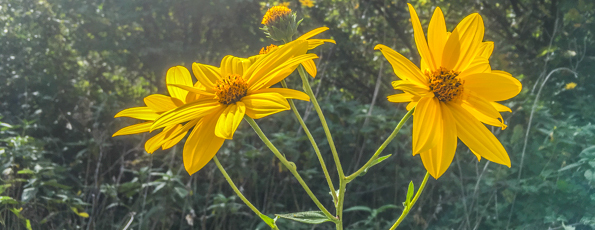
The Makarska Riviera is a beautiful stretch of coastline in the region of Dalmatia in Croatia. Its splendour is enhanced by the impressive Mount Biokovo that stands guard behind the town. Composed of limestone nature has fashioned this huge mountain into a series of peaks, plains and valleys. As the sun sets the rocky outcrops turn a beautiful shade of pink in the fading light.
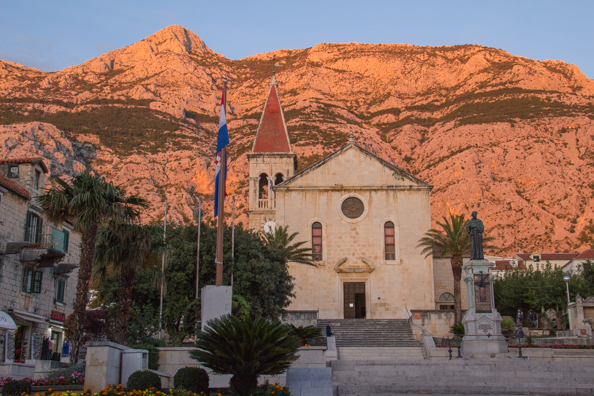
Makarska is the capital town of this riviera that stretches on both sides of it and it is the ideal starting point for some good walking. Our first walk started from the village of Bast on the lower slopes of Mount Biokovo. It was a gentle introduction to the walking in this area. We followed a wide track for a short distance before coming across an ancient standing tombstone at Grebišće just outside the village. This tombstone stands in front of an unexplored graveyard. It is a lovely example of rare example of these tombstones with a ridged top and engraved ancient symbols from prehistoric times. These symbols include half-moons and swastikas. It is not known who occupies this grave but it probably a wealthy inhabitant of Grebišće during the Middle Ages. Our path climbed steadily uphill for over an hour and then our guide decided to test our ability on a narrow path that appeared to go straight down the mountain causing a few gasps of dismay. In fact, it was not as steep as it first appeared as there were regular zigs and zags. However, it was covered in shingle which is common in this area so I was glad I had brought my walking poles with me. I kept my distance from the person in front just in case I should slip over and create an unpleasant domino effect. It was a good introduction to the conditions we would encounter on future walks. The path led us down to the deserted village of Makar which was badly damaged by an earthquake but it is still possible to see the old Dalmatian houses.
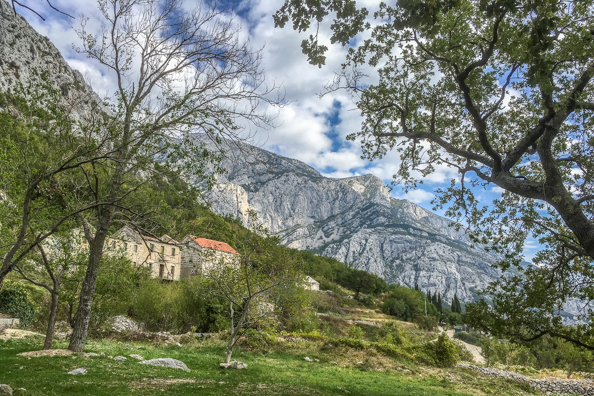
From Makar we continued down a tarmac road to another village, Veliko Brdo. This village, a suburb of Makarska, has also suffered a major catastrophe when fire broke out there in 2008 and all the inhabitants had to be evacuated. Fire as a constant threat in dry weather as there is no surface water due to the porous nature of the limestone. We had a late lunch in the Veliko Brdo Restaurant – a delicious selection of different types of risotto accompanied by a nice light, local beer. After lunch we returned to Makarska by minibus although walking was an option.
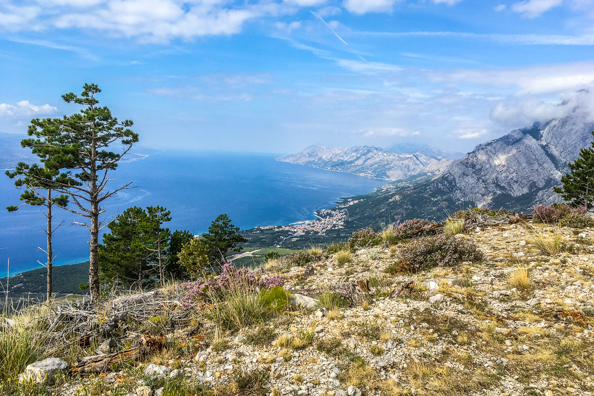
Our second walk also followed paths that criss-cross the lower slopes of Mount Biokovo. We started from the village of Upper Brela. Brela was established as two distinct settlements Upper Brela or Brela Gornja and Lower Brela or Brela Donja, and still exists as two villages in the borough of Brela. We set off on a narrow path that climbed steadily through the trees. Along this educational path we came across several information boards describing places of interest and also giving historical and cultural information about the area. Soon after we set off we came across the pretty little Church of Our Lady of Health. This church was built during the eighteenth century when the threat of the Turks had passed. It is in the style of the rustic form of Baroque that was characteristic of the Dalmatian hinterland. Although it is now in ruins it is still possible to see the inscription ‘1711’ on the little above a front door between huge monolithic door posts. We also passed the Vodice Well described as the fountain of ‘living water’. The surface of Mount Biokovo may be dry but many underground streams pulsing with drinkable water flow beneath its surface.
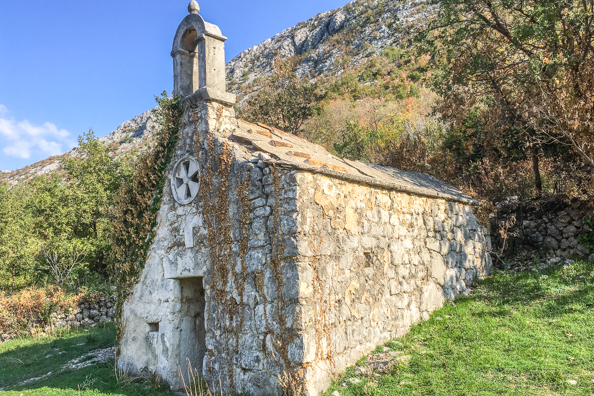
When we emerged from the trees we had a short climb to the Church of Saint Nicholas perched on a rock promontory. This church was built during the pre-Turkish era during the fourteenth or fifteenth century and it is the oldest church in Brela. It has a Gothic vault and a small belfry above its façade – although we were forbidden to ring the bell. It was the parish church of the united parishes of Brela until Upper Brela became an independent parish in 1963. Saint Nicholas has a lot of responsibilities being the patron saint of children, marriageable girls, brides, students, travellers, mariners, spice traders, some countries, cities and villages as well as being the patron saint and protector of the people of Brela. They celebrate his feast of Saint Nicholas at the beginning of Advent. Over the years this church has been renovated several times. During our pause here we spotted a lone chamois on the slopes of the opposite side of the valley
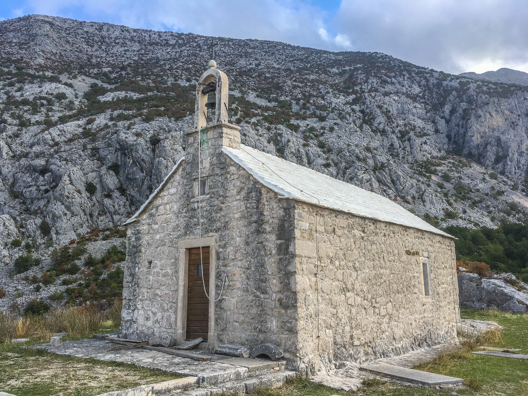
After we left the church there was a long downhill stretch on a wide rocky path but thanks to our ‘training’ the previous day it was relatively easy. This was followed by a short uphill stretch on a path that suddenly emerged on the cliff top at a place known as Nevista. This was the ideal spot for our picnic. We sat in the shadow of the Bride’s Rock a formation steeped in legend. The story goes that a young girl from the upper parts fell in love with a young man from the lower parts. The girl was already betrothed to a young man chosen for her by her family but she was determined to marry her true love. Her mother was opposed to the marriage and having the power to curse (a common talent in those days) she said to her daughter “When you look at the sea I hope that God turns you into stone.” Nevertheless, the girl went ahead with her marriage but did not mention the curse to anyone else. When the happy wedding procession, led by the bridge and groom on horseback, emerged on the cliff top they were all turned to stone. ‘Proof’ can be seen in the shape of the rocks that represent a horse with the bride and groom on it and carrying a loaf of bread and goatskin bottles. If you look more closely you may see the bride’s veil which, at the very moment was blown off her head by the wind. Eerily, the wind suddenly picked up while we were eating and enjoying the fabulous view below us.
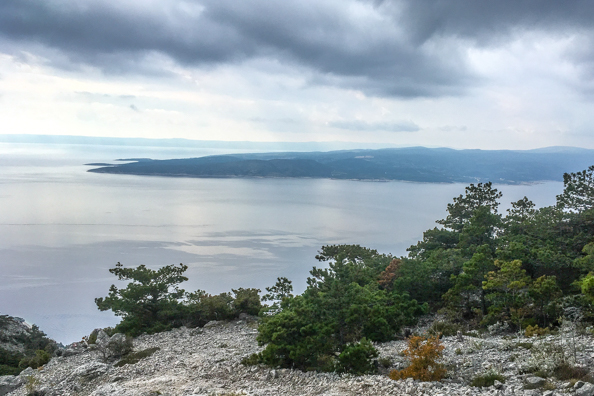
When we set off again we followed a stony path that twisted and turned down the cliff-side. The slopes of Mount Biokovo are littered with dry-stone walls which were built for three reasons. The first was to clean the slopes of the stones, the second was to mark boundaries between properties and the third was to protect against erosion. After a while our path joined a path known as Napoleon’s Road or the French Road. Napoleon had started building this road to move his troops along the coast but it was never completed. This road is also constructed of stones. The wind was still trying to blow us off our feet. The area is renowned for three different winds – bora, jugo (sirocco)and mistral. The strongest is the bora and I am sure it was that wind that was battering us that day. It continued all day, through the night and most of the next day. Fortunately, it dropped before our next walk.

Our third walk started in the village of Kostanje at the church Crkva Sv Mihovila. It was a very pleasant walk through agricultural land. We stopped to pick some fresh figs from a tree overhanging the road asking belated permission from the owner when he came out of his house. Not only did he tell us to carry on he also started picking figs to give to us. The figs were deliciously fresh and sweet. Sometimes we walked by the River Cetina. It was a lovely walk. We stopped in a small village for lunch at a local restaurant on the way. Before eating we had a tasting of their homemade liquors and dried figs from their trees Lunch was very simple but tasty consisting of large platters of local cheese and ham with fresh bread and a very palatable red wine. Rested and refreshed we followed a rocky path down into the valley where a small boat was waiting at the river bank to take us downstream to the town of Omis. During the Middle Ages Omis was famous for its pirates who ruled the local seas from their refuge in the mouth of the river. The fortresses of Omis afforded them impregnable protection. I just had time to climb the lower fortress, the Fortress of Fortress Mirabella or Peovica to enjoy the views of the town and river spread out below me.
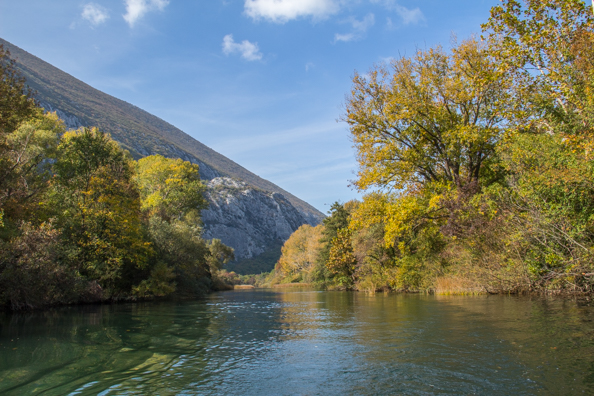
Our last visit to the Biokovo National Park started with the long journey to the highest peak, by bus. The peak of Sveti Jure (Saint George) is 1762 metres above sea level and the highest peak on Biokovo and the second highest peak in Croatia. On this peak is a church of the same name, Ckrkva Sveti Jure. It is not the original church which was a modest seventeenth Christian sanctuary. This church was demolished to make way for a television mast. The present, larger church of the same name was built in 1968 and features a modern representation of Sveti Jure (Saint George). A footpath encircles the peak so that visitors see the church.
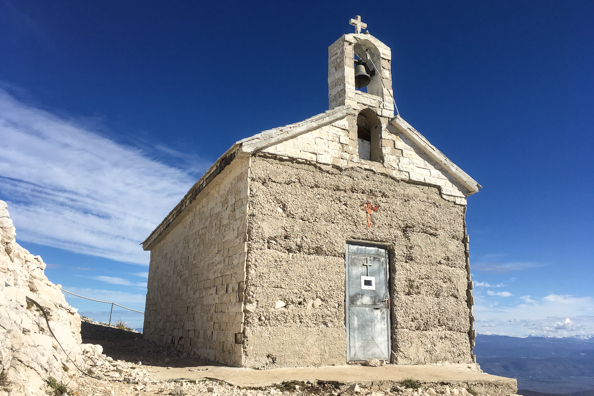
Not far below this peak the group split up and some took a trail to another peak, the Peak of Vosac. The rest of the group went by bus to a car park below this peak and followed a much shorter path to the top to meet up with the other group and then descend together. There is a mountain hut on this peak but as it had already been booked by another group we were unable to use it for our picnic. However, we were able to appreciate the fantastic views of Makarska below us before our descent to a picnic area in the woods below.

I really enjoyed my walks in the Makarska Riviera as the paths are well marked with red flashes, the signposting is good and the views are stunning.
********************************************************************
Getting There
I spent a week in Makarska on a holiday organised by Solos Holidays Ltd. We flew to Split with Norwegian Air and stayed in the modern, sea-front hotel, Hotel Biokovo